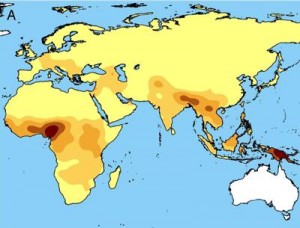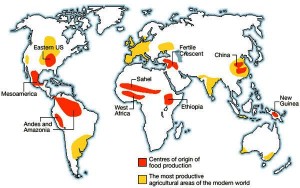- Domesticated sheep spread in two waves.
- How IITA helps yam farmers in West Africa.
- “…it is vital that we develop some sort of early warning system that will enable us to take timely action if we see part of the landscape suffering and signs of the loss of species richness.”
- First issue of newsletter on Agricultural Payments for Ecosystem Services online at Ecoagriculture Partners.
- Visit Cairo’s Agricultural Museum. If you think you can take it.
Language and the spread of agriculture
Whatever you think about the link between the spread of languages and that of farming — and the correspondence between the two postulated by Bellwood is controversial — there is no denying the similarities between a map of language diversity in a recent paper

and that of the places where agriculture originated.

At least in Africa, Near East and New Guinea. The dissimilarities, in particular in South and East Asia, are just as striking.
In praise of Granny Smith
Our regular readers 1 will know that there’s been a regular deluge — windfall? — of apple stories in the past few months, in particular about the imminent demise of the British orchard. The latest surfaced today. In such stories, aspersions are often cast on the qualities of such commercial favourites as the Granny Smith. 2 I guess the unspoken implication is that this and similarly successful varieties are the evil spawn of some sinister multinational, and probably contain, to boot, genes cruelly extracted from some Arctic fish without its prior or informed consent and unnaturally inserted into the pristine apple genome by soulless pointy-headed boffins with Nazi sympathies.
Nothing could be further from the truth, it turns out, at least in the case of the Granny Smith, which was, in fact, spotted as a seedling and first grown by Maria Ann Smith on her farm in Ryde, New South Wales around 1868. 3 It started life as the kind of backyard variety that would later become known as a heirloom. So, I ask myself, what obscure pome, currently languishing in some forgotten British orchard, soon to be rescued by the imminent influx of National Trust money, will eventually knock old Granny from her pedestal? And when will we be complaining about that one?
A little little barley goes a long way
Like I say, not a day goes by. Yesterday, ramie. Today, little barley. As in:
They likely ate sunflower, marsh elder, two types of chenopod—a family that includes spinach and beets—and possibly squash and little barley, according to the findings. The people also grew bottle gourd to make into containers.
That would be the Riverton people living three thousand years ago along the Wabash River in present-day Illinois.
The Riverton crops may have “added to what was [already] a successful life” for the ancient Americans, said Brian Redmond, curator and head of archaeology at the Cleveland Museum of Natural History in Ohio.
Yes, because…
…[b]efore they began farming, the Riverton people lived among bountiful river valleys and lakes, apparently eating a healthy and diverse diet of nuts, white-tailed deer, fish, and shellfish, the study says.
So the Riverton people were not reacting to some environmental stress as a matter of survival when they became agriculturalists, but rather “engaging in a bit of gastronomic innovation.” Good for them.
Featured: Uses of nettels
Christopher Taylor reminds us of the uses of other Urticaceae:
One thing I discovered a while ago when looking up ramie was that nettles themselves (Urtica) contain fibre that can be used in weaving. Nettle fibre isn’t used so much currently because, to be honest, it’s kind of rubbish, but it did have a usage spike in Britain during World War II when better-quality materials such as linen were in short supply.
The multifarious uses of nettles, as coincidence would have it, Jeremy nibbled about only a few days ago.